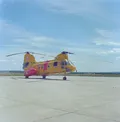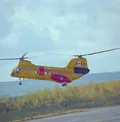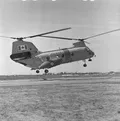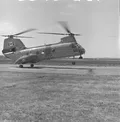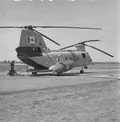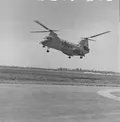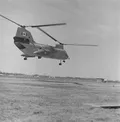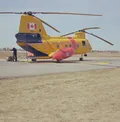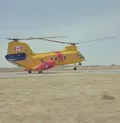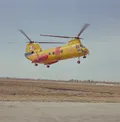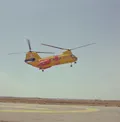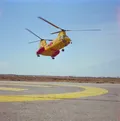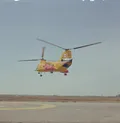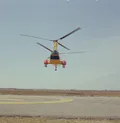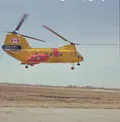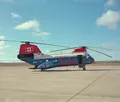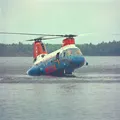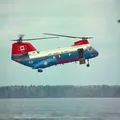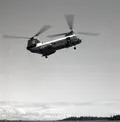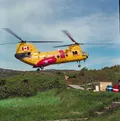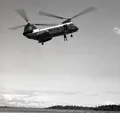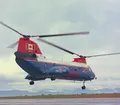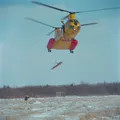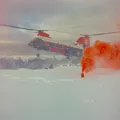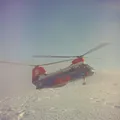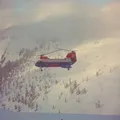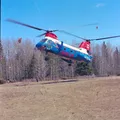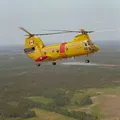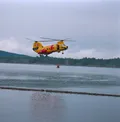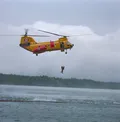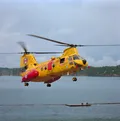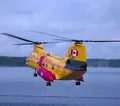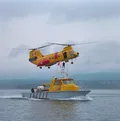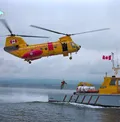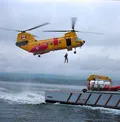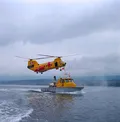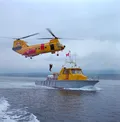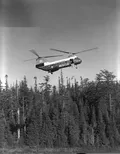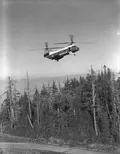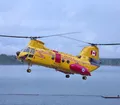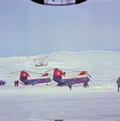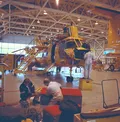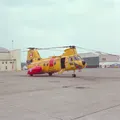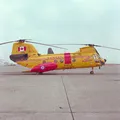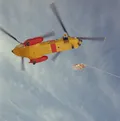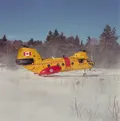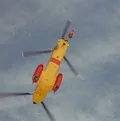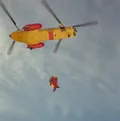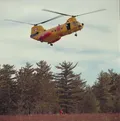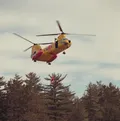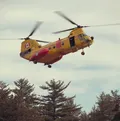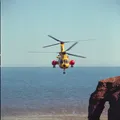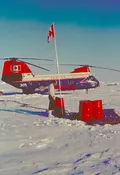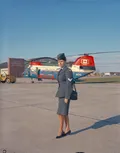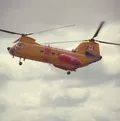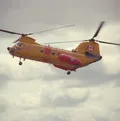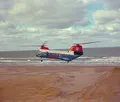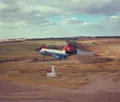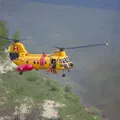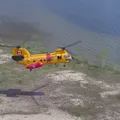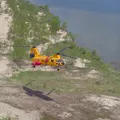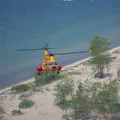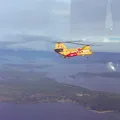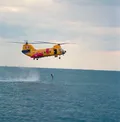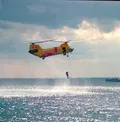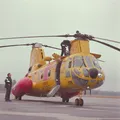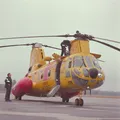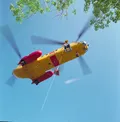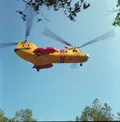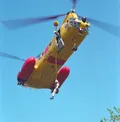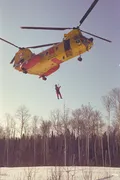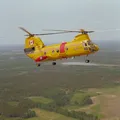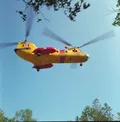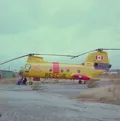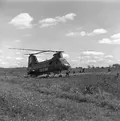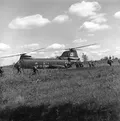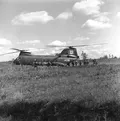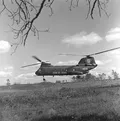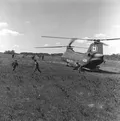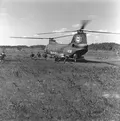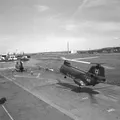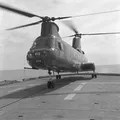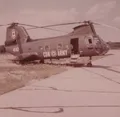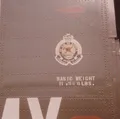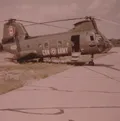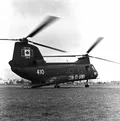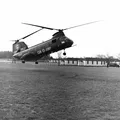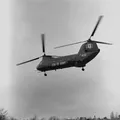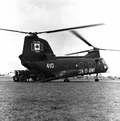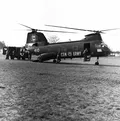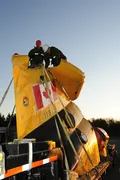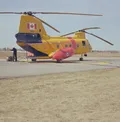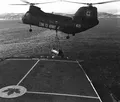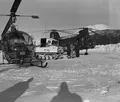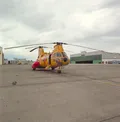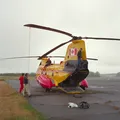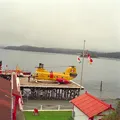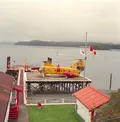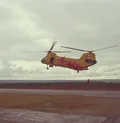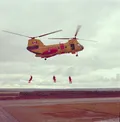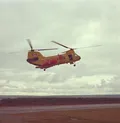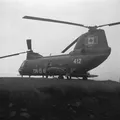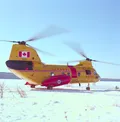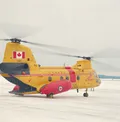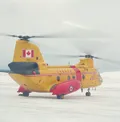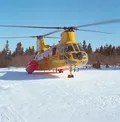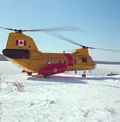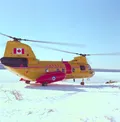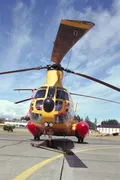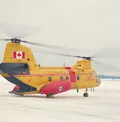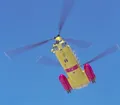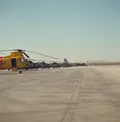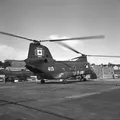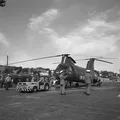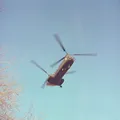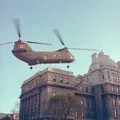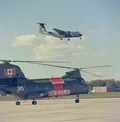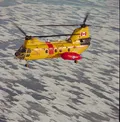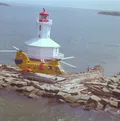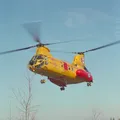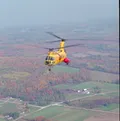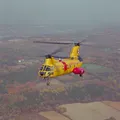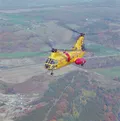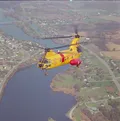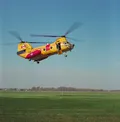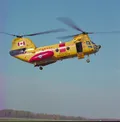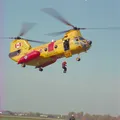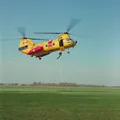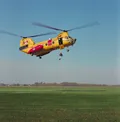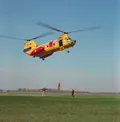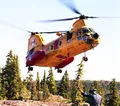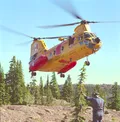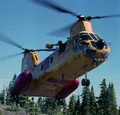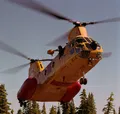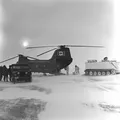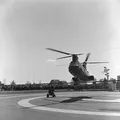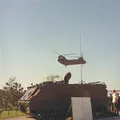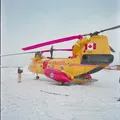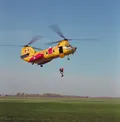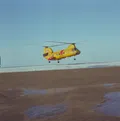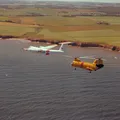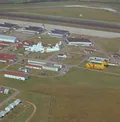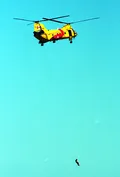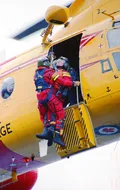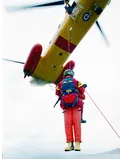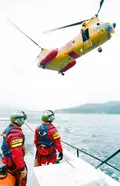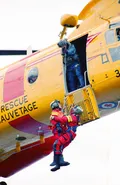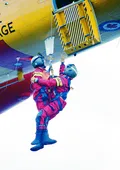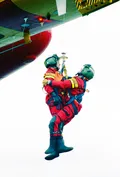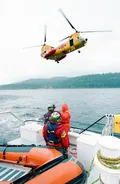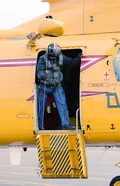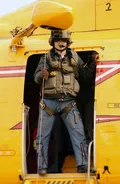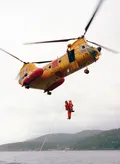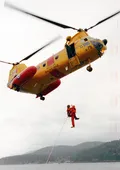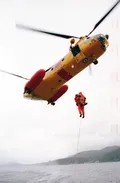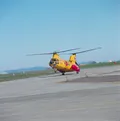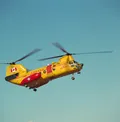Labrador/Voyageur (Total: 19, Canadian: 18, Group 0)
Boeing Labrador/Voyageur
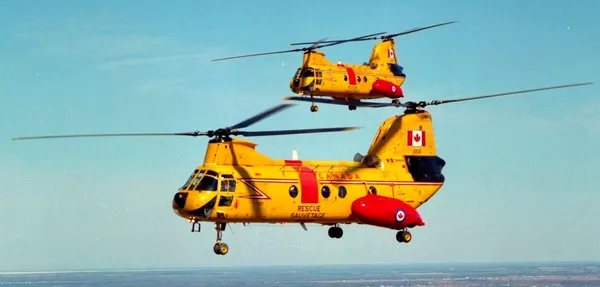
Boeing Vertol CH-113 Labrador (Serial No. 11302), in formation.
The Boeing Vertol CH-113 Labrador was the RCAF Search and rescue version of the American Model 107-II-9 (CH-46) Sea Knight helicopter. The CH-113A Voyageur was the Canadian Army Assault and utility transport version of the Model 107-II-28 helicopter, later converted to CH-113A Labrador.
The RCAF procured six CH-113 Labrador helicopters for the SAR role and the Canadian Army acquired 12 of the similar CH-113A Voyageur for the medium-lift transport role. The RCAF Labradors were delivered first with the first one entering service on 11 October 1963. When the larger CH-147 Chinook was procured by the Canadian Forces in the mid-1970s, the Voyageur fleet was converted to Labrador specifications to undertake SAR missions. The refurbished Voyageurs were re-designated as CH-113A Labradors, with a total of 15 Labradors ultimately in service.
The Labrador was fitted with a watertight hull for marine landings, a 5,000 kilogram cargo hook and an external rescue hoist mounted over the right front door. It featured a 1,110 kilometer flying range, emergency medical equipment and an 18-person passenger capacity. By the 1990s, heavy use and hostile weather conditions had taken their toll on the Labrador fleet, resulting in increasing maintenance costs and the need for prompt replacement. In 1981, a mid-life upgrade of the fleet was carried out by Boeing Canada in Arnprior, Ontario. Known as the SAR-CUP (Search and Rescue Capability Upgrade Program), the refit scheme included new instrumentation, a nose-mounted weather radar, a tail-mounted auxiliary power unit, a new high-speed rescue hoist mounted over the side door and front-mounted searchlights. A total of six CH-113s and five CH-113As were upgraded with the last delivered in 1984. The last CH-113 was retired in 2004. Harold A Skaarup Web Page
![]() Wikipedia Boeing Vertol CH-46 Sea Knight
Wikipedia Boeing Vertol CH-46 Sea Knight
![]() YouTube Labrador Helicopter Boeing Vertol SAR Search and Rescue Demo 1995
YouTube Labrador Helicopter Boeing Vertol SAR Search and Rescue Demo 1995
Labrador/Voyageur CH-113 serial 10401
s/n 10401
as/n 11301
m/d Model 107-II-9
c/n 301
Boeing Vertol
10401
Known Units: 102;424;103;
Registered as N6680D for manufacturer's trials in 1963. Used for cold weather trials at Churchill, Manitoba in winter of 1963/1964. Delivered to 102 (KU) Composite Unit at RCAF Trenton, Ontario. Still there when this unit became 424 (T&R) Squadron in July 1968, and still there when renumbered. Still with this Squadron when Sgt. W.N. Armstrong was killed in an incident involving this helicopter in Nova Scotia on 29 May 1969. Suffered major fire on 22 July 1969, repaired and returned to service.From 11301
Last operational Labrador. With 424 Squadron detachment at Torbay, Newfoundland from January 1977. This became No. 103 Rescue Unit, when it moved to CFB Gander, Nfld. later that year. Rescued 20 survivors from ferry MV William Carson off Square Island, Labrador on 2 June 1977. Still with this unit in 1982, and in 1995. Loaned to 413 Squadron in late 1970s, where it received the name "Miss Piggy", and matching markings, due to its tendency to go unserviceable at odd locations. Detached to Iqaluit, Nunavut in summer of 1991. Served with 424 Squadron, CFB Trenton, Ontario at time of fleet retirement. On display at Museum by December 2005.
last update: 2025-November-19
Unspecified 1969-05-29 to 1969-05-29
() (RCAF) Trenton
Sgt. W.N. Armstrong was killed in an incident involving this helicopter in Nova Scotia.
1971-November-19 Serial Change Became CAF 11301 2019-08-20
Labrador/Voyageur CH-113 serial 10402
s/n 10402
as/n 11302
m/d Model 107-II-9
c/n 302
Boeing Vertol
10402
Known Units: 442;103;413
With 442 Squadron, RCAF Station Comox, BC, when it took part in rescue of crash survivors near Bramfield, Vancouver Island, on 18 July 1965. Because of the height of the trees, the pilot had to lower fuselage into tree tops to allow hoist cable to reach the ground. Pilot Flight Lieutenant D. M. Campbell received Air Force Cross for this mission. Damaged in hard landing at Coldfish Lake, 630 miles north of Vancouver, in 1968, while flying in parts and mechanics to an Albatross . Still with 442 Squadron at integration.From 11302
Served with 442 Squadron, CFB Comox, BC. at integration. With 103 Rescue Unit, CFB Gander, Nfld. in 1982 and in 1995. Served with 413 Transport and Rescue Squadron at CFB Summerside, PEI in 1990. 5 crew members received Star of Courage or Medal of Bravery for rescue of crew of ferry Tessa Kathleen off Anticosti Island on 11 May 1990. Rescued 11 crew members, in 60 knot winds, high waves, and 1/4 mile visibility. Main hoist cable snagged during early lift, most rescues carried out with secondary centre hatch hoist. Rescued lone survivor of tug Patricia B. McAllister off Gaspe on 23 April 1991. Still with this unit at 14 Wing, Greenwood, NS, in 2000. Aborted mission over Northumberland Strait on 4 May 2000 due to suspected generator fire, diverted to beach. After investigation, continued on to Miramichi Airport, NB. Reported stored at CFB Trenton in October 2005, with all markings removed, parked on the AETSS ramp.
last update: 2025-November-19
1971-November-19 Serial Change Became CAF 11302 2019-08-20
Labrador/Voyageur CH-113 serial 10403
s/n 10403
as/n 11303
m/d Model 107-II-9
c/n 303
Boeing Vertol
10403
Known Units: 103;442;413;
Based at RCAF Station Trenton, Ontario, dates unknown. Also with 442 Squadron at CFB Comox, BC, dates unknown. From 11303Served with 413 Transport and Rescue Squadron at 14 Wing, Greenwood, NS, dates unknown. With 442 Squadron, CFB Comox, in 1975, 1979 and 1982. Performed multiple rescues, involving 12 boaters and hikers, following storm on 30 March 1975 while with this unit. MCpl W. Wacey received Star of Courage for this day, which included 9.5 hours flying. With 103 Rescue Unit, CFB Gander in 1975 in red, white and blue scheme. Back with 442 Squadron when it took part in mass rescue from buring cruise ship MV Prinsendam off Alaska coast on 4 October 1980.
MS Prinsendam, a Holland-America Line cruise ship built at Shipyard de Merwede in the Netherlands in 1973, was 427 feet long and typically carried about 350 passengers and 200 crew members. The ship was sailing through the Gulf of Alaska, approximately 120 miles south of Yakutat, Alaska, at midnight on October 4, 1980, when a fire broke out in the engine room. The vessel's master, Cornelis Dirk Wabeke (April 13, 1928 "“ August 16, 2011), declared the fire out of control one hour later and the Prinsendam sent a radio call requesting immediate assistance. The United States Coast Guard at Communications Station Kodiak, Alaska requested that the Prinsendam send out an SOS, but the captain declined. Chief Radio Officer Jack van der Zee sent one out anyway about a half-hour later, which alerted nearby vessels.
United States Coast Guard, USAF Air Rescue Service, and Royal Canadian Air Force CH-113 helicopters which had greater range, rescued the passengers and crew. Two USAF pararescuemen were inserted into one of the lifeboats. This boat was the last rescued with a flare spotted by lookout SN Louis Roderick aboard the USCGC Woodrush which was then relayed to the on-scene commander, USCGC Boutwell. The cutters USCGC Boutwell (WHEC-719), USCGC Mellon (WHEC-717), and USCGC Woodrush (WLB-407) responded in concert with other vessels in the area. The Sohio Intrepid and the Williamsburgh assisted on scene. The Williamsburgh served a vital role as a communications platform and was the first vessel to arrive on scene and take passengers on board. The Sohio Intrepid served as a platform for one of the USAF helicopters that was unable to refuel in flight. The rescue took place during a period of steadily deteriorating weather. The passenger vessel capsized and sank on October 8. The rescue is particularly noteworthy because of the distance traveled by the rescuers, the coordination of independent organizations, and the fact that all 520 passengers and crew were rescued without loss of life or serious injury.[(Wikipedia)
With No. 103 RU in 1983 and 1995 in overall yellow scheme. With 424 Squadron at CFB Trenton, dates not known. Reported stored at Gander in 2003.
last update: 2025-November-191971-November-19 Serial Change Became CAF 11303 2019-08-20
Labrador/Voyageur CH-113 serial 10404
s/n 10404
as/n 11304
m/d Model 107-II-9
c/n 304
Boeing Vertol
10404
Known Units: 442;413
With 442 Squadron at CFB Comox, BC, dates unknown.From 11304
Served with 442 Squadron, CFB Comox, BC in 1980 and 1983. Three crew awarded Star of Courage for rescue mission flown at night, near Squamish, BC, on 27 December 1980. Rescued flood victims from island in the Cheakamus River. Served with 413 Transport and Rescue Squadron at 14 Wing, Greenwood, NS in 1991 and 1995. Rescued crew of Spanish fishing trawler Eduardo Chao off Newfoundland in January 1991. Rescued crew of burning fishing vessel Venture off Nova Scotia on 19 September 1991.
E-mail from Dwayne Harvie, December 2004: "11304 should have a note about the engine failure it suffered in Margaretville NS in 1994, resulting in a "forced landing" in the woods. It was dragged over 5 miles back to base and rebuilt. If my memory serves me, it was also the victim of a self-mutilation in Comox in the late 80's- a high wind start, with the blades hitting the fuselage." The blade strike occurred in May 1987. Reported stored at CFB Trenton in October 2005, parked on the AETSS ramp.
last update: 2025-November-19
1971-November-19 Serial Change Became CAF 11304 2019-08-20
Labrador/Voyageur CH-113 serial 10405
s/n 10405
as/n 11305
m/d Model 107-II-9
c/n 305
Boeing Vertol
10405
Known Units: 103;413;424;442
With No. 413 Squadron at CFB Summerside, PEI.
From 11305:
With No. 103 Rescue Unit, CFB Gander, Nfld., dates unknown. With 424 Squadron at CFB Trenton, dates not known. Landed at North Pole, 1 April 1974, while with 413 Squadron, CFB Summerside, PEI. Performed first mass paradrop at the North Pole, 4 Rescue Specialists, on 27 April 1974. This was part of CF support for Operation Frozen Tusker, a joint scientific and SAR training expedition to the pole. To Boeing Canada in October 1982, for first SARCUP upgrade program. Served with 442 Squadron, CFB Comox, BC in 1983. At Boeing Canada at Arnprior, Ontario for overhaul in February 1995.
Took part in search for survivors of Swissair Flight 111 in September 1998. With 413 T & R Squadron, CFB Greenwood, NS, at time of accident. Broke up in flight, while returning from SAR mission in northern Quebec. All 6 crew died. From official accident report: crew detected number 2 engine fire, dumped fuel after securing engine. JP8 fuel was being used (due to remote operating location), and ignited while being dumped. Fire spread to number 1 engine and aft pylon, resulted in structural failure, and blades striking fuselage.
last update: 2025-November-191971-November-19 Serial Change Became CAF 11305 2019-08-20
Search 1998-10-02 to 1998-10-02
413 () Sqn (RCAF) Greenwood Nova Scotia Canada
Crashed after in-flight engine fire. Wreckage examination showed a fuel leak in the #2 engine compartment of CH11305 resulted in an in-flight fire. In the process of responding to the fire, the crew shut down the engine, activated the fire extinguishing system using the T-handle and commenced fuel dump procedures. The right hand dump tube did not extend during the fuel dump sequence; this increased the possibility of fuel to fuselage contact. The #2 fire T-handle was reset prior to the in-flight break-up; re-introducing fuel and oil into the engine compartment after the fire extinguishing system had been activated, likely re-igniting the fire or causing a small explosion in the # 2 engine compartment. During these actions the dumped fuel was ignited and this set off a catastrophic series of events causing rear rotor blade to fuselage contact and the break-up of the aircraft. Forces precipitated by the aircraft break-up and subsequent ground impact caused fatal injuries to all six crew members.
 1998-October-02 KIFA RCAF Master Corporal Darrell Gerard Cronin CD 2024-05-19
1998-October-02 KIFA RCAF Master Corporal Darrell Gerard Cronin CD 2024-05-19 1998-October-02 KIFA RCAF Sergeant David Leonard Gaetz CD 2023-06-27
1998-October-02 KIFA RCAF Sergeant David Leonard Gaetz CD 2023-06-27 1998-October-02 KIFA RCAF Captain Peter Robert Musselman 2023-06-27
1998-October-02 KIFA RCAF Captain Peter Robert Musselman 2023-06-27 1998-October-02 KIFA RCAF Sergeant Joseph Armand Jean Roy CD 2023-06-27
1998-October-02 KIFA RCAF Sergeant Joseph Armand Jean Roy CD 2023-06-27 1998-October-02 KIFA RCAF Master Corporal Glen Alexander Sinclair CD 2023-06-27
1998-October-02 KIFA RCAF Master Corporal Glen Alexander Sinclair CD 2023-06-27 1998-October-02 KIFA RCAF Captain Darrin Maurice Vandenbliche CD 2023-06-27
1998-October-02 KIFA RCAF Captain Darrin Maurice Vandenbliche CD 2023-06-27 Labrador/Voyageur CH-113 serial 10406
s/n 10406
as/n 11306
m/d Model 107-II-9
c/n 306
Boeing Vertol
10406
Known Units: 442;103;424
With 413 Squadron at CFB Summerside, PEI.From 11306
Served with 442 Squadron, CFB Comox, BC in 1982. With 424 Squadron detachment at Torbay, Newfoundland from January 1977. This became No. 103 Rescue Unit, when it moved to CFB Gander, Nfld. later that year. Rescued 22 survivors from ferry MV William Carson off Square Island, Labrador on 2 June 1977. Served with 413 Squadron at CFB Summerside, PEI on 13 September 1990 when it rescued survivors from FV Marie Paul off Sydney, NS. Still with this unit at CFB Greenwood, NS, in 1995 and 2002. Damaged while starting in high winds, 11 March 2002. Now stored at CFB Greenwood, will be repaired and placed on display.
last update: 2025-November-19
1971-November-19 Serial Change Became CAF 11306 2019-08-20
Labrador/Voyageur CH-113A serial 10407
s/n 10407
as/n 11307
m/d Model 107-II-28
c/n 4001
Boeing Vertol
10407
Known Units: 450;413;424
No. 1 Transport Helicopter Platoon, RCASC, based at CJATC, Rivers, Man. Operational by February 1965. To Edmonton Detachment (RCAF Station Namao, Alberta) summer of 1966. Operation Haylift, Claresholm, Alberta, April and May 1967 (disaster relief following blizzard). Unit renamed 450 (HT) Helicopter Squadron February 1968. Took part in search for escaped prisoners, 26 and 27 August 1968, near Edmonton, Alberta. Later with 450 Squadron at CFB Uplands, Ontario.From 11307
Converted to SAR configuration Labrador 1975. With 413 Squadron at CFB Summerside, PEI, dates unknown. With 424 Squadron at CFB Trenton, Ontario in 1995. With 442 (T&R) Squadron, CFB Comox, BC in 1998. Stored at Comox in 2005, reportedly awaiting sale to Columbia Helicopters.
last update: 2025-November-19
1971-November-19 Serial Change Became CAF 11307. 2019-08-20
Labrador/Voyageur CH-113A serial 10408
s/n 10408
as/n 11308
m/d Model 107-II-28
c/n 4002
Boeing Vertol
10408
Known Units: AETE;103;442;450
Became Instructional Airframe A 697 on 4 September 1964, returned to flight status on 14 August 1969. Used by No. 1 Transport Helicopter Platoon, RCASC, based at CJATC, Rivers, Man. To 450 (HT) Helicopter Squadron (Edmonton Detachment) by end of August 1969.from 11308
Operated by Aerospace Engineering and Test Establishment at CFB Cold Lake, Alberta, dates unknown. Converted to SAR configuration Labrador 1975. Subsequently served with 103 Rescue Unit, CFB Gander, Nfld. Served with 442 Squadron, CFB Comox, BC, 1978 to 1982. In service with 424 Squadron, CFB Trenton, Ontario in 1986, 1988, 1991, 1992, 1995, 1996, and when fleet retired in July 2004. Rescued two stranded workers from top of 500 foot smokestack at Inco refinery in Sudbury, Ontario on 16 September 1986, while with this unit. Delivered to CFSATE, CFB Borden, Ontario, for use as instructional airframe on 19 July 2004. Still at Borden in 2006, and 2008. Disassembled and trucked to CFB Greenwood in early 2010, for eventual display there.
last update: 2025-November-19
1964-September-03 Classified Instructional CA A 697 2020-06-08
1971-November-19 Serial Change Became CAF 11308. 2019-08-20
Labrador/Voyageur CH-113A serial 10409
s/n 10409
m/d Model 107-II-28
c/n 4003
Boeing Vertol
10409
Known Units:
Registered as N4626G for company tests. No. 1 Transport Helicopter Platoon, RCASC, based at CJATC, Rivers Camp, Man. Operational by November 1964. Part of a three ship flight ferrying to St. Hubert, Quebec from Rivers Camp in August 1966. Crashed shortly after take off from Sawyer AFB in northern Michigan. Ran into low clouds, pilot became disoriented after loosing ground contact in low clouds, lost control during attempted climbing turn. Destroyed by post impact fire. One fatality, all 4 others onboard injured.last update: 2025-November-19
1966-August-30 Struck off Strength Struck off, after Category A crash on 14 August 1966. 2019-08-20
Labrador/Voyageur CH-113A serial 10410
s/n 10410
as/n 11310
m/d Model 107-II-28
c/n 4004
Boeing Vertol
10410
Known Units: 450;413;442;424
Registered to Boeing-Vertol as N4633G on 22 March 1965, this registration cancelled 17 May 1965. Delivered to No. 1 Transport Helicopter Platoon, RCASC, based at CJATC, Rivers, Manitoba. Operational by November 1964. Operated from deck of HMCS Bonaventure, July 1965. To Edmonton Detachment, 1966. To Alaska for Exercise Frontier Assault 1967. Later with 450 Squadron at CFB Uplands, Ontario.From 11310
With 413 Squadron, CFB Summerside, PEI, dates unknown. With 450 Squadron when M.Cpl. R.G. Slobogian was killed in an incident involving this helicopter on 8 July 1972. Converted to SAR configuration Labrador 1975. Seen at Trenton in 1976, in partial SAR markings (red band over Army olive drab). With 103 Rescue Unit, CFB Gander, Nfld, in 1982. Flew 8.1 hours on 15 February 1982, searching for survivors of Ocean Ranger oil rig. Refueled on other oil rigs during this mission. With 442 Squadron, CFB Comox, BC in 1991 and 1995. Subsequently operated by 424 Squadron, CFB Trenton, Ontario. Took part in retirement ceremonies and flight display at Trenton, 26 June 2004. Delivered to CFSATE, CFB Borden, Ontario, for use as instructional airframe on 19 July 2004. Still at Borden in 2006 and 2008. Disassembled and trucked to CFB Comox in early 2010, for eventual display there.
last update: 2025-November-19
1971-November-19 Serial Change Became CAF 11310. 2019-08-20
Labrador/Voyageur CH-113A serial 10411
s/n 10411
as/n 11311
m/d Model 107-II-28
c/n 4005
Boeing Vertol
10411
Known Units: 450;442;413
No. 1 Transport Helicopter Platoon, RCASC, based at CJATC, Rivers, Man. Operational by January 1965. To Europe onboard HMCS Provider in 1967, for exercises in Germany. Visited CFB La Macaza, Quebec in September 1968, probably with St. Hubert detachment of 450 Squadron at this time. Later with 450 Squadron at CFB Uplands, Ontario.From 11311
Converted to SAR configuration Labrador 1975. With 103 Rescue Unit, CFB Gander, Nfld, in 1982 and 1983. Also reported with 413 Squadron at Summerside in 1982 and 1983. Serving with 442 Squadron at CFB Comox, BC at time of crash. Was hoisting stranded hikers when engine failure at high altitude caused crash at 5,000 foot level in mountains near Bella Coola, Vancouver Island. One fatality, Cpl. P.L.C. Young.
last update: 2025-November-19
1971-November-19 Serial Change Became CAF 11311 2019-08-20
Labrador/Voyageur CH-113A serial 10412
s/n 10412
as/n 11312
m/d Model 107-II-28
c/n 4006
Boeing Vertol
10412
Known Units: 450;413;442
Registered to Boeing-Vertol as N4635G for compnay tests. No. 1 Transport Helicopter Platoon, RCASC, based at CJATC, Rivers, Man. Operational by January 1965. Took part in Exercise White Caribou 1966. Later with 450 Squadron at CFB Uplands, Ontario.From 11312
Converted to SAR configuration Labrador 1975. Reported with 413 Squadron, CFB Summerside, PEI, in 1982, may be in error. Serving with 442 Squadron at CFB Comox, BC in 1993, 1995, and 1997. Rescued survivors of crash of 11311 on 30 April 1992. To Winnipeg, April/May 1997, during floods. Reported stored at CFB Trenton in October 2005, with all markings removed, at the AETSS ramp.
last update: 2025-November-19
1971-November-19 Serial Change Became CAF 11312. 2019-08-20
Labrador/Voyageur CH-113A serial 10413
s/n 10413
as/n 11313
m/d Model 107-II-28
c/n 4007
Boeing Vertol
10413
Known Units: 450
To No. 1 Transport Helicopter Platoon, RCASC, based at CJATC, Rivers, Manitoba on 2 February 1965. Operational by February 1965. To Edmonton Detachment (RCAF Station Namao, Alberta) 23 September 1966. Took part in Red Deer, Alberta air show, 4 and 5 August 1967. Flown by Capt. G. C. Walker and Lt. Houle. Lifted dinosaur bones at Trochu, Alberta for University of Alberta Paleontology Department on 19 September 1967, flown by Capts. G. C. Walker and Davis. Believed to be first helicopter airlift of dinosaur bones in Canada. Unit renamed 450 (HT) Helicopter Squadron, CAF February 1968. Still with this unit, by then based at CFB Uplands, when renumbered. While based at Uplands this aircraft became the personal favourite of Prime Minister P. Treadeau, and regularly flew him and his party around eastern Canada.
From 11313
To Boeing Canada at Arnprior for repainting and fly in repairs, back to 450 Squadron at Namao on 8 March 1973. Serving with 450 (HT) Squadron at time of crash. 3 fatalities: Captain Ronald Raymond Fleming CD, Captain Ronald George Davidson, and Master Corporal Malcolm Ross Caton.
. last update: 2025-November-191971-November-19 Serial Change Became CAF 11313 2019-08-20
 1974-March-19 KIFA RCAF Master Corporal Malcolm Ross Caton 2024-04-29
1974-March-19 KIFA RCAF Master Corporal Malcolm Ross Caton 2024-04-29 1974-March-19 KIFA RCAF Captain Ronald George Davidson 2024-04-29
1974-March-19 KIFA RCAF Captain Ronald George Davidson 2024-04-29 1974-March-19 KIFA RCAF Captain Ronald Raymond Fleming 2024-04-29
1974-March-19 KIFA RCAF Captain Ronald Raymond Fleming 2024-04-29 Labrador/Voyageur CH-113A serial 10414
s/n 10414
m/d Model 107-II-28
c/n 4008
Boeing Vertol
10414
Known Units: 450
Delivered from Boeing Canada, Arnprior, Ontario, to CJATC on 8 to 10 March 1965, by Captains G. C. Walker and Danford. Served with No. 1 Transport Helicopter Platoon, Royal Canadian Army Service Corps, based at Canadian Joint Air Training Centre, Rivers, Manitoba. To Europe onboard HMCS Provider in 1967, for exercises in Germany. Serving with 450 (HT) Squadron at time of crash (St. Hubert detachment?).last update: 2025-November-19
1971-July-23 Struck off Strength Struck off, after Category A crash at Lansing, Michigan on 15 July 1971. 2019-08-20
Labrador/Voyageur CH-113A serial 10415
s/n 10415
as/n 11315
m/d Model 107-II-28
c/n 4009
Boeing Vertol
10415
Known Units: 450;424;414;103
No. 1 Transport Helicopter Platoon, RCASC, based at CJATC, Rivers, Man. Operational by February 1965. To Edmonton Detachment (RCAF Station Namao, Alberta) summer of 1966. Unit renamed 450 (HT) Helicopter Squadron, CAF February 1968. Took part in Moose Jaw air show, 9 June 1968, flown by Capts. G. C. Walker and Binney. Flew photographic cover for 500 ton blast at CFB Suffield, Alberta, 9 August 1968, flown by Capts. G. C. Walker and Davis. Later with 450 Squadron at CFB Uplands, Ontario.From 11315
Serving with 450 Squadron, CFB Uplands, when replaced by Chinooks in 1975. Converted to SAR configuration Labrador 1975. Initially operated in olive drab paint with temporary rescue markings. Served with 424 Transport and Rescue Squadron, CFB Trenton, Ontario from October 1975. Rescued crew of crashed Fox Moth at Toronto air show, 5 September 1976, while with 424 Squadron. Moved with 424 Squadron detachment to Summerside, PEI in October 1976, and then to Newfoundland by 1977. With 413 Squadron, CFB Summerside, PEI, 1982. With 103 Rescue Unit, CFB Gander, Nfld, 1983. Back to 424 Squadron by February 1995. Preserved at RCAF Memorial Museum, Trenton, Ontario by fall of 2005. Still there in 2023.
last update: 2025-November-19
1971-November-19 Serial Change Became CAF 11315. 2019-08-20
Labrador/Voyageur CH-113A serial 10416
s/n 10416
as/n 11316
m/d Model 107-II-28
c/n 4010
Boeing Vertol
10416
Known Units: 450;424;442
With No. 1 Transport Helicopter Platoon, RCASC, based at CJATC, Rivers, Manitoba by May 1966. To St. Hubert detachment 1967. Later with 450 Squadron at CFB Uplands, Ontario.From 11316
Converted to SAR configuration Labrador 1975. Served with 424 Transport and Rescue Squadron, CFB Trenton, Ontario. Moved with 424 Squadron detachment to Summerside, PEI in October 1976, and then to Newfoundland by 1977. With 442 Squadron, CFB Comox, BC in 1982, and in 1995. Back with 424 Squadron at Trenton on 24 November 1990, when it evacuated injured girl from cabin 250 miles north of Thunder Bay, Ontario. Reported stored at CFB Trenton in October 2005, with all markings removed, at the AETTS ramp.
last update: 2025-November-19
1971-November-19 Serial Change Became CAF 11316. 2019-08-20
Labrador/Voyageur CH-113A serial 10417
s/n 10417
m/d Model 107-II-28
c/n 4011
Boeing Vertol
10417
Known Units:
No. 1 Transport Helicopter Platoon, RCASC, based at CJATC, Rivers, Man. Lost control during boost-off training, largely destroyed by post impact fire. One fatality, Capt. S.F. Hand. First Voyageur / Labrador crash, and first fatality. Training procedures revised after this crash.
last update: 2025-November-191965-December-21 Struck off Strength Struck off, after Category A crash on 27 September 1965, near CJATC. See Comments. 2019-08-20
Labrador/Voyageur CH-113A serial 10418
s/n 10418
as/n 11318
m/d Model 107-II-28
c/n 4012
Boeing Vertol
10418
Known Units: 450;442;413
With No. 1 Transport Helicopter Platoon, RCASC, based at CJATC, Rivers, Manitoba by May 1966. Later with 450 Squadron at CFB Uplands, Ontario.From 11318
Converted to SAR configuration Voyageur in 1975. Received SARCUP upgrade in 1982/1983, renamed Labrador at that time. Served with 442 Transport and Rescue Squadron at CFB Comox, British Columbia. Also served with 413 Squadron, CFB Summerside, PEI, in 1982. Back with 442 Squadron in 1991, 1993, and 1995. Picked up survivors of fishing vessel Juju from another fishing boat on 19 March 1993, north of Vancouver Island, and transferred them to hospital. Reported stored at CFB Trenton in October 2005, with all markings removed, parked at the AETSS ramp.
last update: 2025-November-19
1971-November-19 Serial Change Became CAF 11318. 2019-08-20




